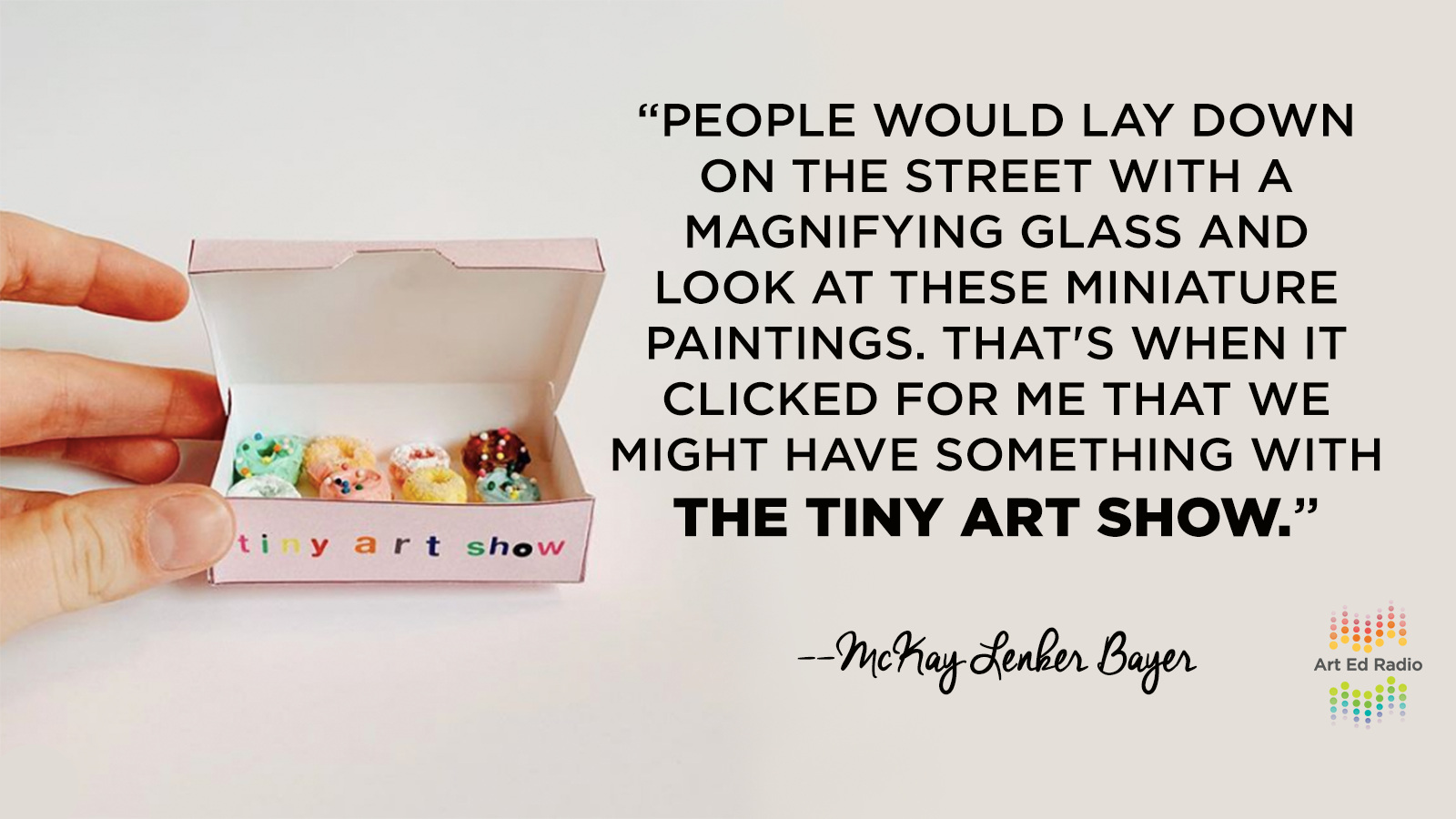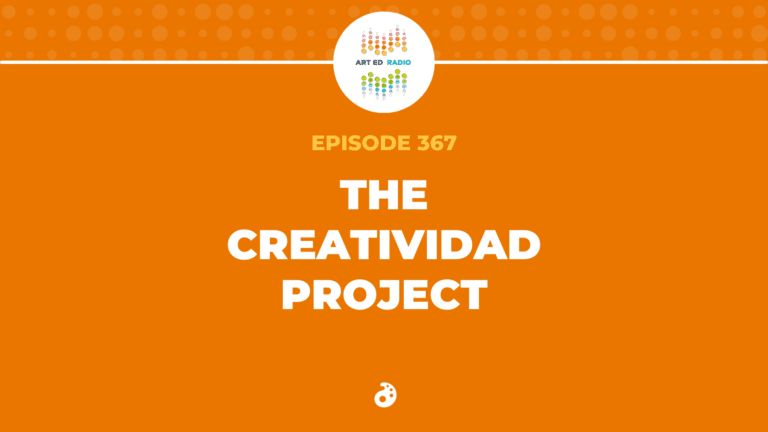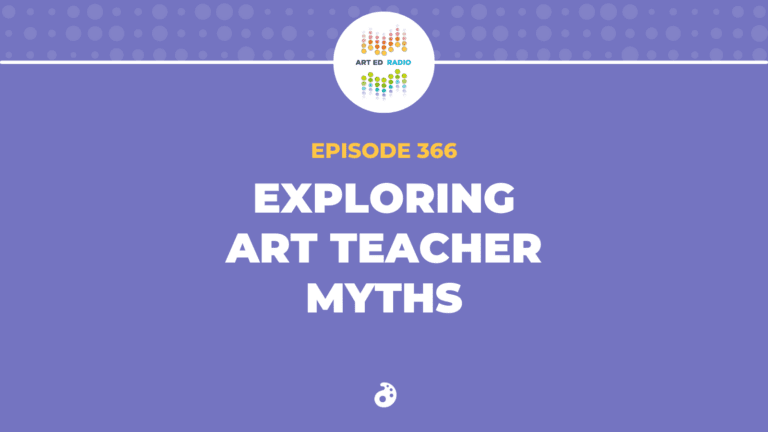You have probably seen the Tiny Art Show popping up all over Facebook and Instagram lately–a tiny version of the galleries we know so well, just unique and more accessible. Today, the art teacher behind the Tiny Art Show–McKay Lanker Bayer–comes on the show to talk with Tim about how it got started, how she gets her students involved, and where the Tiny Art Show goes from here. Full episode transcript below.
Resources and Links

Transcript
Tim: Welcome to Art Ed Radio, the podcast for teachers. This show’s produced by the Art of Education University, and I’m your host, Tim Bogatz.
If you are anything like me, you have been absolutely fascinated by the Tiny Art Show photos that have been popping up all over social media. I love the concept, the idea, the execution, and just everything involved. Today, we’re going to talk to the person behind the Tiny Art Show, McKay Lanker Bayer. McKay is an art teacher in Provo, Utah. She has been bringing some Tiny Art Shows to unexpected places. I’ll just say, these shows are amazing. Tiny little canvases that are all hung exactly a foot off the ground. Tiny food, tiny silverware, tiny lights, even tiny little velvet ropes. Everything you’d need for a gallery opening, just in miniature.
I think the best way to explain it, as I read with McKay in an interview she did, when she said that you should imagine that you are shrunk down to be a tiny person, and this gallery is part of your universe. So yeah, imagine that, picture that. Then, think about trying to navigate it as a full size person. You can’t see all of the details, you really need to spend some time, spend some energy to figure out what’s really going on. And, my personal favorite part, the magnifying glasses to help you take it all in. It’s just an amazing concept that really asks a lot of the viewers, but is really interesting at the same time. So we’re going to talk to McKay about that in just a minute.
But, first, we need to talk about the Art Ed Now Conference. So last week on Thursday, as promised, we announced the featured presenter Ron Clark. Now, if you don’t know Ron Clark, he is a two times New York Times bestselling author, and he was also dubbed by Oprah Winfrey as her first phenomenal man. He is an amazing educator, and you will love hearing from him as he talks about his career in education, his passion for working with kids, and some stories about his founding of the Ron Clark Academy. It’s going to be an exciting and inspirational talk. You are not going to want to miss is. So you can find out more about the conference and reserve your spot at ArtEdNow.com. The first 2,000 registrants get a free swag box. It is full of products, and samples, and test materials to try in your art room. A lot of people say that is the best part of the conference. Those get taken really quickly, so do not wait to reserve your spot. Actually, right now, hit pause on the podcast, go register for the conference. Then, after you’re registered, you can come back here and we’ll listen to the interview that’s coming up right now.
All right, McKay Lanker Bayer is joining me now. McKay, how are you today?
McKay: I’m pretty good.
Tim: Good, I’m glad to hear it. We obviously need to talk today, a lot about Tiny Art Shows, and everything that you’ve put together there. But, before we do that, first of all, can you tell us a little bit about you and about your teaching? I think people will kind of want to know who you are and what you do, so can you just kind of give people a little background on where you’re coming from here?
McKay: Sure, totally. So I’m from South Carolina, but I live in Provo, Utah. I went to BYU and got my bachelor’s in art education. I love community art. I guess I would consider myself a community artist. I started out teaching, the very first art I ever taught was at a homeless shelter, and I did that for two years before I graduated. Now, I am a full time high school art teacher, and this is my second year of teaching.
Tim: Okay, very cool. I like that. Yeah, I love those sort of experiences outside the classroom. I think they’re really valuable, and they can always teach us a lot. But, let’s talk about the Tiny Art Show that you’ve put together. We want to know the history behind it, of course. I’d love to know kind of your inspiration, the ideas behind it, how you brought it about, how it got started, and kind of how it’s grown since then? Can you just kind of give us the rundown of everything that you’ve done with it?
McKay: Sure. The history, so I guess if we go way, way back, when I was little, my mom was really into, she’s kind of a … she loves reading, she was an English teacher. She loves stories and books, and kind of all these imagination-related things. So she instilled that in me really early on, so we would make fairy houses together. I had a playroom where she painted all the walls to be kind of these fantastic things. There was a beanstalk with a castle at the top, and this tree. I’d always make up stories about all of these worlds and I collected tiny things. My mom would write me tiny letters from fairies, and she’d leave them in the fairy houses that I would make. So very early on I just loved tiny things and just kind of this sense of childhood and these other worlds. Fast forward to college, I was kind of implementing that a lot in my work. I did this series of tiny doors. I called them treehouses. I’d put them on the bottoms of tree trunks, like a little house, and set up this cute little, kind of like fairy houses almost. I was also doing lots of tiny paintings with those canvases you can just buy at Walmart for a dollar.
Tim: Right, right. Yeah.
McKay: They have a tiny easel. So I was just doing that for fun, I had these little paintings. I was in an art and business class, and my professor gave us an assignment to curate our work and show it somewhere in public. I had never done that before, and I think it was my junior or maybe my senior year. I was close to graduating, but I had never shown my work.
Tim: Okay.
McKay: Which I was kind of ashamed of, and I didn’t know how to break past that. I had these tiny paintings, and I just was thinking, “Oh, it would be kind of fun to show them, exhibit them, but everything is small scale, so they’ll have tiny labels and a tiny name, and maybe a light.” I just decided to do it, and I did it. I put it out on a street, like in a little corner of a street, and I hung the art really low down, and tiny labels, and I left some magnifying glasses out there. Then, I just sat a couple feet away at a table and just would watch to see if people noticed it. It was like my favorite thing that I had ever done, and I was so excited when people would notice it. People would get down, like lay down on the ground, the dirty street, to look at the art, and scooch up really close with the magnifying glass and look at each painting.
It kind of clicked for me that it was something that was really cool, especially because it got people to notice that there’s cool things happening all around us. It also, I don’t think I’ve seen very many times normal people, not normal people, but just everyday people, stopping to take that much time to really inspect a piece of art. I feel like looking at art is just something that artists and art historians and art collectors do, it’s not a normal thing. So yeah, I did that in college, then, I graduated and I kept every now again I’d just have this nagging feeling like, “I should keep doing that. That was really fun. I really loved that.”
But, I started teaching and I got busy. I got a part time job with the city that I live in doing arts and events, stuff like that. On the Instagram for the city, for the downtown Provo part of the city, the question was asked, “What’s your favorite hidden gem in downtown Provo?” And somebody responded and said, “The Tiny Art Gallery that was on the street.” That was kind of my wake up call that I needed to start doing it again. So six months ago, I just was like, “Okay, I’m going to do it and give it my all. This time I’m going to do different artists. I’ll curate the shows, but it’ll be different artists each time, and it’ll be in a different location.” It’s just grown from there.
Tim: Yeah, that’s really cool. Now, I actually wanted to ask you, I guess, about locations, about putting things together. Let me ask you this, as you’re putting together these amazing little shows, can you describe or kind of tell us about the working process? How you plan things, like you said, how you find venues and artists, methods for creating, or curating everything, and just kind of like what it takes to put everything together?
McKay: Yeah, totally. So because of my job, my part time job for the city, well, specifically downtown Provo, I help to direct, it’s called the Art Stroll here. But, like a gallery walk, that type of thing. So I work really closely with a lot of local businesses downtown, so it was very natural for me to be able to connect with them. Do you know what I mean?
Tim: Mm-hmm (affirmative).
McKay: Part of Tiny Art Show is, I want to pick artists that are really unique and really amazing, that are local, and then put them into spaces that are also local and unique, like you can’t find this space anywhere else. So that’s pretty much how each show goes. I usually have an artist in mind first, and then I will choose a space that matches their vibe, or something similar to that. Yeah, a lot of the stuff that I’ve been doing is really just trial and error, it’s a process. I’m always realizing that I should be doing something, and I’m like, “Why didn’t I think of this sooner?” But yeah, I think having that connection with downtown Provo, and because I get to work with these artists already for the Art Stroll, really helps it, because I wasn’t just some random stranger saying, “Hey, can I put this miniature thing here?” So yeah.
Tim: I think that’s cool. If I can just kind of follow up with that too, as you’re selecting artists and locations, how much do you think about the audience for the Tiny Art Show? When you’re putting this together, are you wanting the audience to focus more on the art itself, or more on the experience of the show, the laying down in the street, as you were talking about, or is it a case of everyone who comes might take away something different from the show?
McKay: That’s such a good question. Well, first of all, I’ve been trying to pick artists that are different. I don’t want it to just every show to be just my taste in art, even though I like every artist, obviously. But, yeah, the bigger question, and I think my answer is, I hope that whoever comes to a Tiny Art Show can take away something new. So if someone’s coming for the experience, or even just coming for an Instagram picture like, “Oh, it’s fun to have a tiny cookie and sit by a Tiny Art Show.” But, then, when they come, they’re actually looking at the art and they take the tiny booklet with them that has information in a little artist’s statement, and now they’ve been to an art show. So the next time they encounter one, it’s not going to be as foreign to them. And vice versa, I think people who come to see the artists’ work, because I’ve had some artists who have a bigger following. I’ve had people come just because they want to buy the work, or they want to see the work, and they realize it’s this fun experience and they keep coming back, and they get exposed to new artists, and they also get to experience this more fun, playful side of art that’s not always there.
Tim: Yeah, that’s really cool. Yeah, I feel like it’s kind of taken on a life of its own on social media. You have this huge following on Instagram, and I’ve seen some features that have been written about Tiny Art Show. I assume you want to kind of keep developing this and going on beyond social media, so for you, what’s next on the agenda? How do you want to keep growing this? What do you want to do in the future with it?
McKay: Well, one thing is, I’d love to be able to travel and take Tiny Art Shows to new places. I’ve thought about having a traveling show, but I also really love the idea of going to a city and then showing an artist that’s from there in a place that’s unique to there, because I feel bad sometimes, because most of the stuff I do is in Utah, so people that are around the country or the world are like, “I wish I could be there, I wish this was in my city.” I just feel like I wish I could do it everywhere and everyone could have this fun experience. I also would love to just keep pushing the idea more and more. I have this really amazing opportunity to participate in a pop-up art, interactive art museum this summer, so that will be cool. I can’t say that much about it right now, but it’s going to be really cool and kind of different from anything else I’ve done so far. But, yeah, I love that there’s lots of opportunities to keep expanding this idea and seeing how far I can take it. Ultimately, I just want to keep bringing that kind of excitement, and wonder, and surprise of seeing something that transports you into this other fun world. Also, making the art world more accessible. Those are probably my two biggest goals.
Tim: Yeah, no, I think those are really worthwhile. I think the accessibility is just something that you’re doing so well, because so many people, like you said a little bit ago, are just kind of intimidated by an art show. But, if you sort of breakdown the barriers to that and kind of make something that’s creative, or unique, or more inviting, then I think you’re able to do that, and I think that’s been really effective and very cool to see.
McKay: Thank you.
Tim: But, I also wanted to kind of ask about this in a different way, because I think that’s the goal for a lot of art teachers as well, just trying to make things more accessible for the kids in our classroom. So question to you is, what lessons come back to the classroom with you from doing Tiny Art Shows? How do they affect your teaching and what you talk about with your kids?
McKay: Yeah, one of the biggest things, going back and kind of drawing from my own experiences, I was really scared to exhibit my art, and I didn’t know how. That art and business class I took kind of helped, but I felt like I was way behind and everyone else was already exhibiting, even just in coffee shops and stuff like that. But, I just was like, “I just don’t know how to …” It is kind of scary to hang art and curate art, because there’s this other side of it, the maybe less artistic, where you have to measure and make sure everything is level and these kind of things that they don’t teach as often. So I love the idea of being able to give my students this early on experience with curating, and talking about what a curator is, because a lot of times people don’t think about how much effort goes into a gallery or a museum. Just the way that the art is displayed, how your eye is supposed to go, how they want you to feel as you see a sequence of art.
My students come to my Tiny Art Shows a lot and they are really cute and they really love it, and a lot of students will be like, “Do you need help with the Tiny Art Show? What can we do?” Because I’m always, when they’re working sometimes, I’ll bring the stuff in, because I cut out the booklets, little tiny booklets by hand.
Tim: Oh yeah.
McKay: So if they’re finished early or after school, they’ll say, “Can I help you cut out something.” Some of them are kind of invested in it too, and they really like it. So it’s fun, and it’s even fun to have an assignment where everyone makes a piece of tiny art and then we display a Tiny Art Show at school with tiny labels, magnifying glasses. Then, they actually get to help decide, “Okay, these paintings, I think these go well together, and this will lead the viewer down to this next group of work.” So it’s a lot easier to show them how to curate than hanging a normal show, but it’s just as fun and cute.
Tim: Yeah, no, I think that’s awesome. I think that’s a great experience for them too. I think it’s really cool for them to be able to be a part of that. I think it’s something they’ll remember for a long time. Go ahead.
McKay: Oh, I was just going to say, one other thing, I’ve gotten to work with artists who are way more established, they’re full time artists, and I’ve learned so much from them that I get to take back to my students, because I do have quite a few students who say, “I want to be an artist full time.” And they ask me about how can they sell their art or this and that, and it’s easier for me to give them better advise, because I get to work with these artists, which I wasn’t really doing before.
Tim: No, see, that’s good for everybody. I mean, it’s good for the kids to broaden their horizons, it’s awesome for those artists to make more connections, and like you said, it makes you more knowledgeable as a teacher. So all of that is really, really worthwhile. So cool. All right. Well, McKay, thank you for joining us. I really appreciate you giving us some time, telling us all about Tiny Art Shows. Then, just before we go, can you tell everybody where to follow you on social media, and kind of say a little bit more about what’s going on with the Tiny Art Show?
McKay: Yes, totally. Our Instagram is just @tinyartshow, and our Facebook is also, Facebook.com/tinyartshow.
Tim: Perfect.
McKay: So there you go.
Tim: No, that sounds awesome, and hopefully we’ll introduce a few more people to your work. So thank you very much.
McKay: Thank you so much.
Tim: Thank you to McKay for coming on. I talked way too much at the beginning because I’m just so excited about the concept of the Tiny Art Show, so we’ll just try and wrap this up really quickly here. Let me say this, I love McKay’s ideas about kind of breaking down those barriers, about bringing art to new places, and making things more accessible. Not just accessible in terms of who’s viewing the show, but also in terms of who’s producing the show, like when her kids, the kids in her classroom, are seeing that this type of art is accessible to everyone, and that these shows are something that they can do. That is a really powerful message, and it’s something that I think our kids in all of our classrooms would do well to learn as well.
Art Ed Radio is produced by the Art of Education University, with audio engineering from Michael Crocker. Like I said at the beginning, Ron Clark is coming to Art Ed Now. He’s going to have an amazing presentation, so go to ArtEdNow.com, register for the conference, and make sure you get a swag box. It is going to be an awesome time in July, we’ll make sure we see you there, and we’ll also make sure we talk to you next week. Thanks for listening.
Magazine articles and podcasts are opinions of professional education contributors and do not necessarily represent the position of the Art of Education University (AOEU) or its academic offerings. Contributors use terms in the way they are most often talked about in the scope of their educational experiences.



